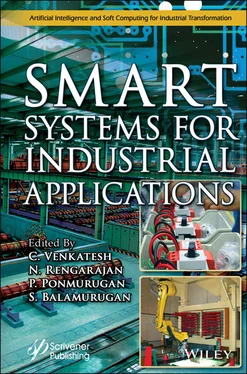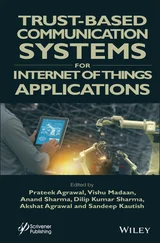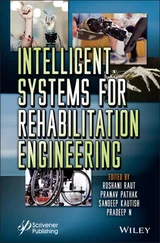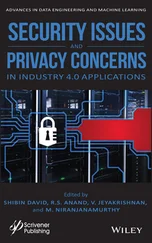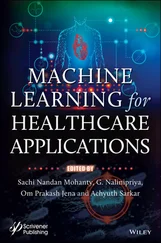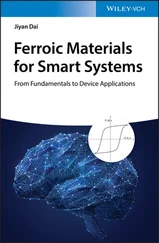Smart Systems for Industrial Applications
Здесь есть возможность читать онлайн «Smart Systems for Industrial Applications» — ознакомительный отрывок электронной книги совершенно бесплатно, а после прочтения отрывка купить полную версию. В некоторых случаях можно слушать аудио, скачать через торрент в формате fb2 и присутствует краткое содержание. Жанр: unrecognised, на английском языке. Описание произведения, (предисловие) а так же отзывы посетителей доступны на портале библиотеки ЛибКат.
- Название:Smart Systems for Industrial Applications
- Автор:
- Жанр:
- Год:неизвестен
- ISBN:нет данных
- Рейтинг книги:3 / 5. Голосов: 1
-
Избранное:Добавить в избранное
- Отзывы:
-
Ваша оценка:
- 60
- 1
- 2
- 3
- 4
- 5
Smart Systems for Industrial Applications: краткое содержание, описание и аннотация
Предлагаем к чтению аннотацию, описание, краткое содержание или предисловие (зависит от того, что написал сам автор книги «Smart Systems for Industrial Applications»). Если вы не нашли необходимую информацию о книге — напишите в комментариях, мы постараемся отыскать её.
The prime objective of this book is to provide an insight into the role and advancements of artificial intelligence in electrical systems and future challenges.
Audience
Smart Systems for Industrial Applications — читать онлайн ознакомительный отрывок
Ниже представлен текст книги, разбитый по страницам. Система сохранения места последней прочитанной страницы, позволяет с удобством читать онлайн бесплатно книгу «Smart Systems for Industrial Applications», без необходимости каждый раз заново искать на чём Вы остановились. Поставьте закладку, и сможете в любой момент перейти на страницу, на которой закончили чтение.
Интервал:
Закладка:
Authors Bhavani et al . organized the integration of pocket-size ultrasound (POCUS) with mHealth devices to deal with heart diseases. In the reporting, there were around a total of 253 patients with heart diseases, which are randomized into two groups of mHealth clinics and standard healthcare. The pocket-size echocardiography was used from remote on medical decision-making with patients who have valvular heart diseases. The mHealth devices are associated with minimum referral time for intervention and improved probability of intervention in comparison with standard healthcare. mHealth also decreases the death rate and hospitalization. In work, the authors have embedded POCUS with mHealth devices and verified that the embedding could be performed in previous medical clinics with the required clinical outcome.
1.3.2 The Adaptability of POCUS in Telemedicine
Thus, POCUS has enabled point-of-care screening to resource-limited communities. The screening is associated with cardiovascular diseases. Moreover, the scanning of 1,023 studies was done in a remote place whose images were sent to the physicians for review through internet-based platforms. The sending and reviewing process was completed with the median time of 11:44 h. This study has proved that the remote assessment of echocardiographic has an added value of using internet-based assessment for cardiac illnesses.
The interpretation of images from remote was tested in a smartphone. Around 83 patients images were sent to remote locations and tested in smartphone applications. It is observed that the non-expert diagnosis was revised by remote experts.
It is also possible to apply deep learning and machine learning in the analysis of echocardiography. It is shown that the algorithms like random forests and support vector machines could distinguish between hypertrophic cardiomyopathy and athlete heart more precisely than any traditional measures. Moreover, supervised learning approaches with the required number of ECG variables verified the superiority of machine learning algorithms by distinguishing between restrictive cardiomyopathy and constrictive pericarditis [17].
The usage of deep learning algorithms for image classification is very obvious. These kinds of applications are useful in computer vision. The algorithms can recognize the patterns in heterogeneous syndromes and cardiovascular images. The deep learning methods can improve the accuracy of 2D STE and other modalities of imaging [18, 19]. The idea can be extended to other imaging modalities, namely, 3D STE and cardiac image of magnetic resonance imaging kind. The deep learning algorithms work well even in noisy data, namely, strain imaging. The diseases like Takotsubo cardiomyopathy, hypertension, Brugada syndrome, heart failure, and atrial fibrillation can also be diagnosed with deep learning algorithms. An autonomous interpretation of echocardiography was successfully implemented through a deep learning algorithm by Zhang et al . [20]. Using the data collection of 14,000 samples, the algorithm could successfully distinguish between broad echocardiographic view classes (e.g., short axis and parasternal long axis) with an accuracy of 96%.
Automated quantification of cardiac structure with the help of Convolutional Neural Networks (CNNs) was superior to manual measurements. Moreover, authors have trained the CNN to detect pulmonary artery hypertension, cardiac amyloidosis, and hypertrophic cardiomyopathy with high accuracy. These evolutions prove that the idea of embedding AI techniques in mHealth devices has become a reality. Machine learning and deep learning techniques are an effective means of handling the sheer complexity of the data. While comparing with other disciplines, cardiologists have numerous amounts of data at their disposal. Since the data complexity grows, it is important for an AI technique to be embedded in the clinical practice. So, it is expected in the future that all cardiologists to be data scientists and physicians simultaneously.
The summary of the above discussed articles on AI-driven mHealth communication is listed in Table 1.3.
1.4 AI-Driven Body Area Network Communication Technologies and Applications
The development and growth of wireless sensor networks play a vital role in the field of medical and health servicing sectors. In modern technology, wireless communication provides a lot of possibilities for the sharing of information at anytime and anywhere. The main objective of this chapter is to explore body area network communication technologies driven by AI. Medical AI mainly utilizes computer network topologies to perform monitoring, recording, diagnoses, and treatment process [21].
Table 1.3 Impact of AI-mHealth communication system in healthcare.
| Source | Subject matter | Role of AI-Driven mHealth devices | Related performance measures |
| [12–14] | Medical big data analysis | Personalized clinical decision-making | A complex diagnosis process in multiple chronic illnesses became simplerSimilarities in illness patterns are analyzed effectively |
| [15] | Digital healthcare | Health Monitoring - Continuous Glucose Monitoring (CGM)CardioMEMS Heart Sensor with Wireless implantable Hemodynamic Monitoring (W-HM)Automated diagnostic algorithm | POCUS uses in heart diseasesCGM early detects hypoglycemic episodesW-HM results in 30% reduction in heart failure readmissions (hazard ratio 0.70, 95% confidence interval 0.60–0.84) |
| [16] | Atrial fibrillation detection | C statistic–based trained ANN using smart watch data | ANN predicts AF with 90.2% specificity and 98% sensitivity |
| [17] | Echocardiographic evaluation | Machine learning–based Associative memory classifier | Achieves 22% more accuracy in prediction than SVM. |
| [18, 19] | Transthoracic 3D Echocardiography (TTE) Left Heart Chamber Quantification | Automated Adaptive Analytics Algorithm | Achieves better correlation (r = 0.87 to 0.96) with manual 3D TTE |
| [20] | Echocardiogram Interpretation | CNN-based detection trained with 14 035 Echocardiogram images | CNN detects hypertrophic cardiomyopathy, cardiac amyloidosis, and pulmonary arterial hypertension with 95% accuracy. |
A body area network has wide applications in medical and non-medical fields. In the medical field, they are either used as wearable devices or implanted in a patient’s body or as a remote monitoring system to keep track of patient’s health based on the sensory nodes positioned in their bodies. This is very sensitive to older adults or patients with chronic diseases. Through biomedical sensors, motion detectors, and wireless communication, monitoring of every activity like glucose, blood pressure, and pulse rate is done. Figure 1.5shows a typical body area network with wearable devices for health monitoring. All the required information is collected through the central hub and processed wirelessly to the healthcare provider or medical staff during emergencies. The end devices can also be wearable [22–24], which act as transducers to display human activities, temperature, and pressure.
Communication in the body sensor network is of two types.
1 (i) In-body communication uses RF signals between sensory nodes, which are implanted in our human body. The frequency at which the communication has to take place is defined by Medical Implantable Communication Service (MICS), and the range of frequency is 402–405 MHz
2 (ii) On-body communication is the communication between wearable sensory nodes, which consists of biosensors. Ultrawideband (UWB) can be used for on-body communication. IMS based, which is mainly used for industrial, medical, and scientific applications having a range of 2.4–2.485 GHz. Many electronic applications operate on this band.
Читать дальшеИнтервал:
Закладка:
Похожие книги на «Smart Systems for Industrial Applications»
Представляем Вашему вниманию похожие книги на «Smart Systems for Industrial Applications» списком для выбора. Мы отобрали схожую по названию и смыслу литературу в надежде предоставить читателям больше вариантов отыскать новые, интересные, ещё непрочитанные произведения.
Обсуждение, отзывы о книге «Smart Systems for Industrial Applications» и просто собственные мнения читателей. Оставьте ваши комментарии, напишите, что Вы думаете о произведении, его смысле или главных героях. Укажите что конкретно понравилось, а что нет, и почему Вы так считаете.
